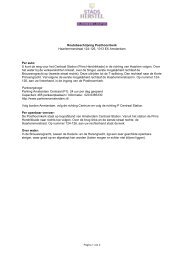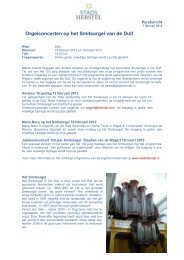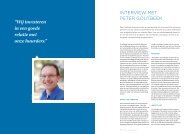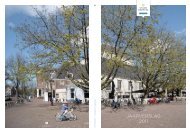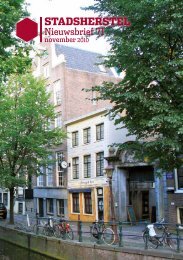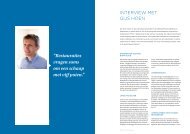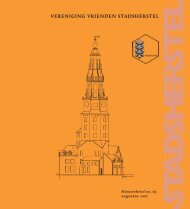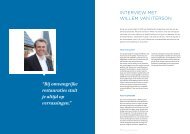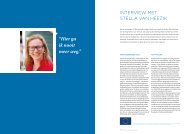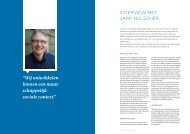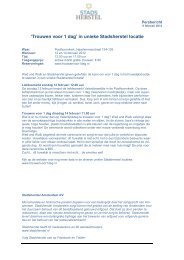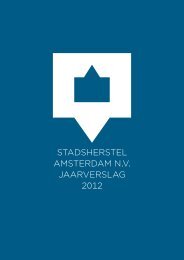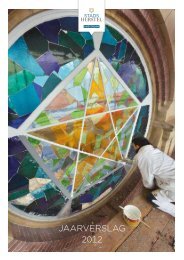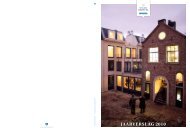StadSherStel amSterdam
StadSherStel amSterdam
StadSherStel amSterdam
- No tags were found...
You also want an ePaper? Increase the reach of your titles
YUMPU automatically turns print PDFs into web optimized ePapers that Google loves.
Restoration of Domeon the EindenhoutEstate, HaarlemIn the gardens of the former Eindenhout estate outside Haarlem – better known as the ‘Housewith the Statues’ – stands a unique dome. This dome has been awaiting restoration for a longtime; a demolition permit had even been issued for the complete removal of the structure. Fortunately,Stadsherstel Amsterdam and Rescura joined forces and approached the Haarlem municipalitytogether in search of a solution. Thanks to this partnership, the dome - once so beautiful,but now decrepit - is being restored to its former glory.The Eindenhout EstateA house existed on the site of the Eindenhout estateas early as 1630. It was located next to the inn ‘HetDronckenhuisje’ and was also used as a pub knownas ‘Het Nieuwe Dronckenhuisje’ until 1685. At thebeginning of the18th Century, the estate acquiredthe name ‘Eindenhout’. At the end of that century,in 1793, the wealthy Amsterdammer George GerardLans had the present house built. It was designedby Pierre Esaie Duyvené, an architect from Lans’shome town. Around 1802, the next owner, JacobTemmick, beautified the estate and installed thetwo marble sphinxes from Italy. In 1963, the Haarlemmunicipality acquired ownership of the estate.The municipality’s main interest was in the groundssurrounding the house and the gardens were setup as a public park as an extension of the Haarlemmerhoutwood. The house itself fell into disrepairand was sold in 1972 to the antiquarian H.F. Bill ofAmsterdam, who had it restored.DemolitionThe dome, located by the Haarlemmerhout woodclose to the Wagenweg/Spanjaardslaan crossroads,is one of the first examples of the use of reinforcedconcrete in the Netherlands. It may even be thevery first structure created in reinforced prefabricatedconcrete and this is one of the reasons that itis a national monument. Neglected for decades, itwas in such poor condition that it seemed impossibleto preserve it. Despite the efforts of ‘Stichting ’tKoepeltje’ (founded 1984) to save the structure, theprocedure to delete it from the national list begana few years ago and a demolition permit had evenbeen issued.Rescue PlanRestorationThe restoration is proceeding apace. At present, thedome is completely packed away, but in Septemberthe monument will be back in pristine condition.The intention is to officially complete the workduring Open Monument Weekend of 12th and13th September although, regrettably, the gardendome will not be completely restored to its formercondition by then. To avoid the dome becoming agathering place for youths, the Haarlem municipalitydecided that the roof should not be replaced.That had already fallen in by 1948, probably due tothe weight of the statue of a siren that surmountedit. During the neighbourhood festival, ‘CultuurlijnBosch & Vaart’, on 14th June 2009, interested partiescan mount the scaffolding to view to dome inits current poor state.When Stadsherstel Amsterdam (which is increasinglyactive in Haarlem) heard this news, it decidedto make a last-ditch attempt to save this uniquepiece of architecture. The restoration companyRescura was called in, and an inspection showedthat restoration was possible. The concrete wasstill in good shape, but the reinforcement on theoutside was completely rusted through. The stuccowork of the decorations on the concrete was also inpoor condition. Fortunately, one of the eight pillarswas still almost as good as new. This could be usedto make moulds for the repair of the stucco workon the other pillars. The two sphinxes that stood infront of the dome were also in reasonable conditionand were refurbished in the Rescura workshop.They are copies of the ones that stand in frontof Eindenhout House. The Haarlem municipalityprovided money to carry out the restoration.The Building of theGarden DomeThe dome was built in ‘artificial stone’ in 1915 bythe Amsterdam firm Rooker & Achterberg. It wascommissioned by the estate owner at that time,H.A. van Odijk. Odijk was the owner of the country’sbiggest rice mill, C. Kamphuys in Zaandam.The ‘temple’, as the Odijk family called the dome,served as a place of rest in the extensive gardens.The temple is similar to the 19th-century ‘Templeof Diana’ in the gardens of the Villa Pallavicini-Durazzo at Pegli near Genoa. The dome is also avery important piece of art history. It is regarded asa folly: a whimsical, artistic structure with no purposeexcept to decorate the surroundings and offera place to rest for a while.The dome is also a veryimportant piece of arthistory. It is regardedas a folly: a whimsical,artistic structure withno purpose except todecorate the surroundingsand offer a placeto rest for a while.24 | 25 |



